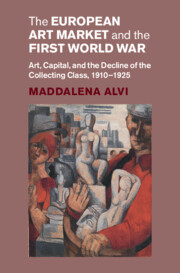 The European Art Market and the First World War
The European Art Market and the First World War Book contents
- The European Art Market and the First World War
- Studies in the Social and Cultural History of Modern Warfare
- The European Art Market and the First World War
- Copyright page
- Dedication
- Epigraph
- Contents
- Figures
- Acknowledgements
- Introduction
- 1 The European Market before 1914
- 2 The Great Conflagration (1914–1918)
- 3 ‘Wartime Cultural Changes’ (1914–1918)
- 4 Postwar Markets (1918–1925)
- 5 ‘The Challenges of New Markets’
- 6 Cementing Nationalisation (1918–1925)
- Conclusion
- Bibliography
- Index
2 - The Great Conflagration (1914–1918)
Published online by Cambridge University Press: 10 April 2025
- The European Art Market and the First World War
- Studies in the Social and Cultural History of Modern Warfare
- The European Art Market and the First World War
- Copyright page
- Dedication
- Epigraph
- Contents
- Figures
- Acknowledgements
- Introduction
- 1 The European Market before 1914
- 2 The Great Conflagration (1914–1918)
- 3 ‘Wartime Cultural Changes’ (1914–1918)
- 4 Postwar Markets (1918–1925)
- 5 ‘The Challenges of New Markets’
- 6 Cementing Nationalisation (1918–1925)
- Conclusion
- Bibliography
- Index
Summary
The First World War marked a shift from liberalism and internationalism to a period characterised by nationalisation, ethnicisation of citizenship, and economic protectionism. The art market’s history aligns with these narratives, highlighting the fragmentation of a European trade zone and the disruption of a transnational trade equilibrium. The war prompted significant structural transformations in these markets, with Germany seeing a surge in art investment as a hedge against inflation. In Britain, art sales were driven by tax obligations and national service investments. Conversely, the French market struggled, facing stagnation and a focus on preserving existing collections due to the threat of destruction. Neutral countries such as the Netherlands and Switzerland maintained stable art markets, fostering avant-garde movements and serving as hubs for buyers and sellers. The year 1914 catalysed structural transformations in these markets, highlighting how modern warfare altered art’s perception, value, and trade.
- Type
- Chapter
- Information
- The European Art Market and the First World WarArt, Capital, and the Decline of the Collecting Class, 1910–1925, pp. 66 - 104Publisher: Cambridge University PressPrint publication year: 2025
